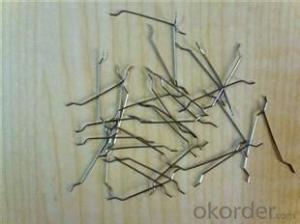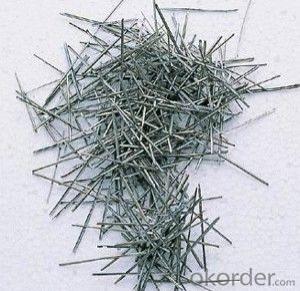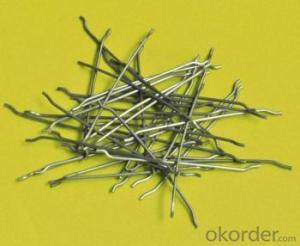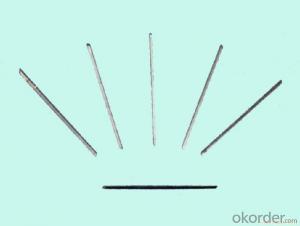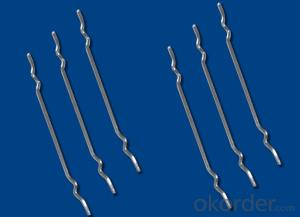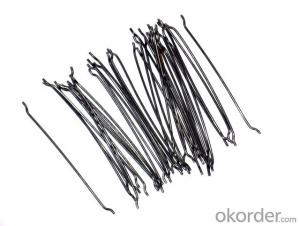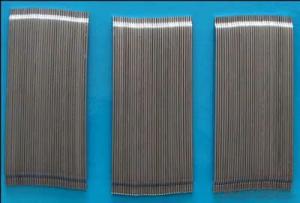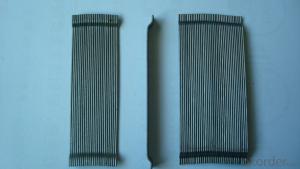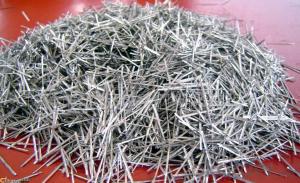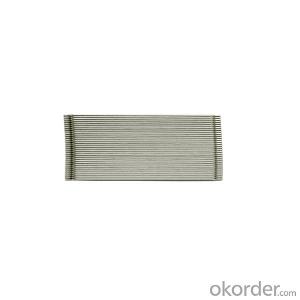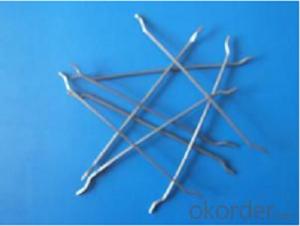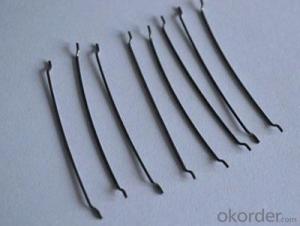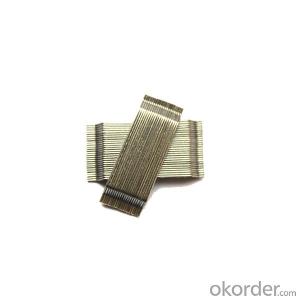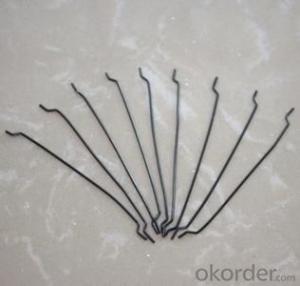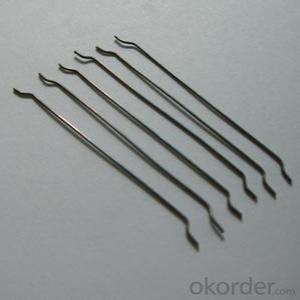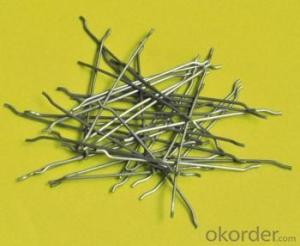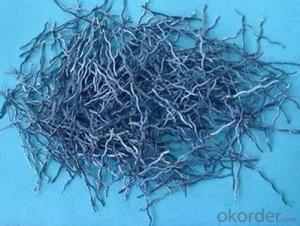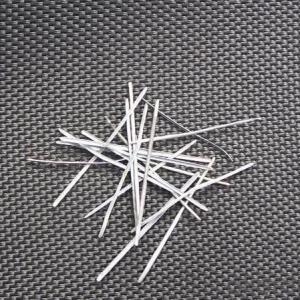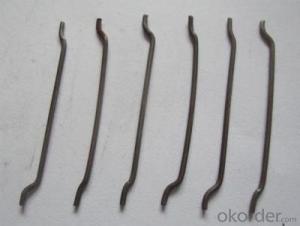Melt Extract Stainless Steel Fiber 0.9/50 Concrete Steel Fiber from CNBM China
- Loading Port:
- Tianjin
- Payment Terms:
- TT OR LC
- Min Order Qty:
- 1 m.t.
- Supply Capability:
- 5000 m.t./month
OKorder Service Pledge
Quality Product, Order Online Tracking, Timely Delivery
OKorder Financial Service
Credit Rating, Credit Services, Credit Purchasing
You Might Also Like
Quick Details
Place of Origin: Tianjin, China (Mainland)
Model Number: 0.9
Material: Steel
Production Process: Cold drawn
Lengh: 50
Type: 1
Compressive Strength: >1200MPa
Aspect ratio: 56
Standard: ASTM A820M-11
Section Shape: Circular
Application: Concrete Reinforcement
Packaging & Delivery
| Packaging Details: | 20 kg/Bag,50 bags/Pallet or 1,000kg/ Bulk Bag |
|---|---|
| Delivery Detail: | 1 Month |
Product Description
| Diameter | 0.90 | mm | 0.04 | in |
| Length | 50.00 | mm | 1.96 | in |
| Aspect Ratio | 56 | |||
| Tensile strength | 1200 MPa | |||
| Type | Cold drawn Steel Fiber | |||
| End | Hooked-end Steel Fiber | |||
| Glued/Loose | Glued Steel Fiber | |||
| Bending Angle | 45°(min.30°) | |||
| Usage & Performance | Floor:Trafficked areas and Industrial floors | |||
| Shotcrete :Slope stabilization and Final lining | ||||
| Precast concrete:Pipe and Railway sleepers | ||||
| Packing | Standard Export Pallet Packing | Bag Packing | 20 kg/Bag,50 bags/Pallet | |
| Bulk Packing | 1,000kg/ Bulk Bag | |||
| Loading Quantity | 20’GP | 20-25 Tonne/Tonnes | ||
| 40’GP | 25-27 Tonne/Tonnes | |||
| 40’HQ | 25-27 Tonne/Tonnes | |||
| MOQ | 1 kg for trial order | |||
| Supply Ability | 10,000 Tonne/Tonnes per Year | |||
| Payment Terms | T/T or L/C at sight | |||
| Delivery Time | Within 15 days after receiving deposit or original L/C at sight | |||
| Certification | ISO9001:2000, CE, | |||
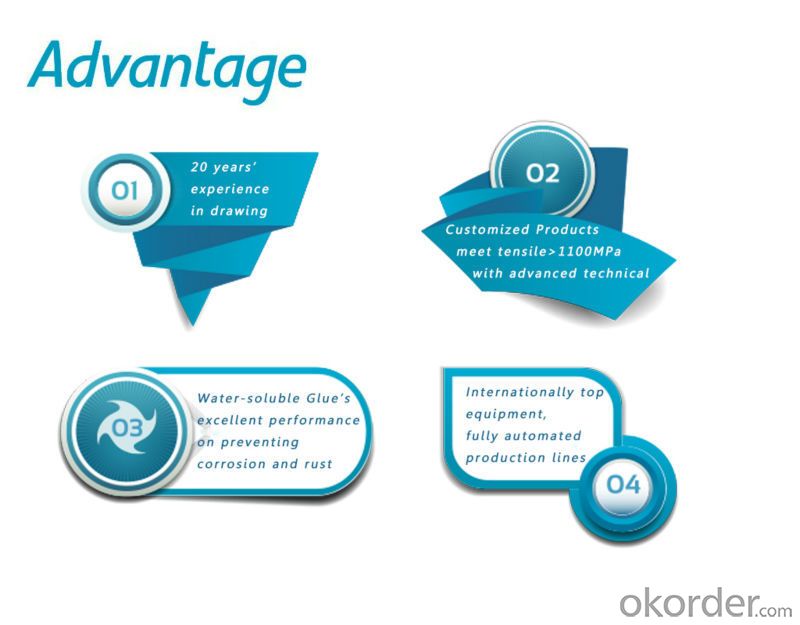
| Product | Diameter | Length mm/in | Aspect Ratio | Type | Packing |
| G-6030 | 0.5 mm (0.0197 in) | 30 mm (1.1811 in) | 60 | Glued | 20 kg/Bag, or 1,000kg/ Bulk Bag |
| G-6535 | 0.55 mm (0.0217 in) | 35 mm (1.3780 in) | 65 | Glued | 20 kg/Bag, or 1,000kg/ Bulk Bag |
| G-6035 | 0.6 mm (0.0236 in) | 35 mm (1.3780 in) | 60 | Glued | 20 kg/Bag, or 1,000kg/ Bulk Bag |
| G-8060 | 0.75 mm (0.0295 in) | 60 mm (2.3622 in) | 80 | Glued | 20 kg/Bag, 50 bags/Pallet |
| G-6060 | 0.9 mm (0.0354 in) | 60 mm (2.3622 in) | 60 | Glued | 20 kg/Bag, 50 bags/Pallet |
| G-6030 | 0.5 mm (0.0197 in) | 30 mm (1.1811 in) | 60 | Loose | 20 kg/Bag, or 1,000kg/ Bulk Bag |
| G-6535 | 0.55 mm (0.0217 in) | 35 mm (1.3780 in) | 65 | Loose | 20 kg/Bag, or 1,000kg/ Bulk Bag |
| G-6035 | 0.6 mm (0.0236 in) | 35 mm (1.3780 in) | 60 | Loose | 20 kg/Bag, or 1,000kg/ Bulk Bag |
| G-8060 | 0.75 mm (0.0295 in) | 60 mm (2.3622 in) | 80 | Loose | 20 kg/Bag, 50 bags/Pallet |
| G-6060 | 0.9 mm (0.0354 in) | 60 mm (2.3622 in) | 60 | Loose | 20 kg/Bag, 50 bags/Pallet |
- Q: Does melt extract stainless steel fiber improve the freeze-thaw resistance of concrete?
- Yes, melt extract stainless steel fiber does improve the freeze-thaw resistance of concrete.
- Q: Can melt extract stainless steel fiber be used in tunnel segmental lining rehabilitation?
- Certainly! Melt extract stainless steel fiber proves effective for tunnel segmental lining rehabilitation. This particular fiber finds widespread use in concrete applications, augmenting the material's mechanical properties. The incorporation of stainless steel fibers into the concrete mix enhances its tensile and flexural strength, mitigating cracking while bolstering its resistance to impact and abrasion. When employing concrete for the repair or reinforcement of tunnel linings during segmental lining rehabilitation, the addition of melt extract stainless steel fibers further fortifies the durability and structural integrity of the material. Such measures effectively extend the tunnel's lifespan while ensuring its secure and efficient operation.
- Q: Can melt extract stainless steel fiber be used in high-temperature refractory applications?
- Yes, melt extract stainless steel fiber can be used in high-temperature refractory applications.
- Q: Can melt extract stainless steel fiber be used in tunnel construction?
- Yes, melt extract stainless steel fiber can be used in tunnel construction. Stainless steel fibers are known for their high tensile strength, corrosion resistance, and durability, making them suitable for applications where structural integrity is crucial, such as tunnel construction. These fibers can enhance the mechanical properties of concrete, improving its resistance to cracking, thermal expansion, and shrinkage. Additionally, stainless steel fibers can provide reinforcement in tunnel linings, reducing the need for traditional reinforcement methods like rebar. This results in cost savings and faster construction times. Overall, melt extract stainless steel fiber is a reliable and effective choice for tunnel construction projects.
- Q: How does melt extract stainless steel fiber improve the durability of fiber-reinforced concrete?
- Melt extract stainless steel fiber is a highly effective material that significantly enhances the durability of fiber-reinforced concrete. This type of fiber, made from stainless steel, offers several key advantages that contribute to the overall strength and longevity of the concrete. Firstly, the addition of melt extract stainless steel fiber improves the crack resistance of fiber-reinforced concrete. These fibers are highly tensile and have a superior ability to distribute stress throughout the concrete matrix. As a result, they help to prevent the formation and propagation of cracks, even under high loads or extreme temperature fluctuations. By reducing the occurrence of cracks, the overall durability and lifespan of the concrete structure are greatly enhanced. Secondly, melt extract stainless steel fibers have excellent corrosion resistance properties. Unlike other types of fibers, stainless steel fibers are highly resistant to chemical attacks and the corrosive effects of moisture and aggressive substances. This resistance to corrosion ensures that the fibers maintain their structural integrity over time, even in harsh environments. Consequently, the concrete reinforced with melt extract stainless steel fibers is better equipped to withstand the deteriorating effects of exposure to water, chemicals, and other corrosive elements. Additionally, melt extract stainless steel fibers improve the impact and abrasion resistance of fiber-reinforced concrete. The strong and ductile nature of stainless steel fibers allows them to absorb and disperse energy more effectively. This property makes the concrete more resistant to impacts, such as heavy loads or dynamic forces, which can cause cracking or surface damage. By enhancing the concrete's ability to withstand these external forces, the overall durability of the structure is significantly improved. Furthermore, the addition of melt extract stainless steel fiber enhances the overall toughness of fiber-reinforced concrete. The fibers act as reinforcement, providing additional strength and ductility to the concrete matrix. This increased toughness allows the concrete to better resist various forms of loading, including bending, tension, and compression. As a result, the concrete becomes less prone to failure or damage, leading to a longer service life and improved durability. In conclusion, melt extract stainless steel fiber greatly improves the durability of fiber-reinforced concrete by enhancing crack resistance, corrosion resistance, impact and abrasion resistance, as well as overall toughness. These fibers provide structural reinforcement and help to distribute stress, preventing the formation and propagation of cracks. Additionally, their resistance to corrosion ensures long-term structural integrity, even in harsh environments. The increased impact and abrasion resistance, as well as the enhanced toughness, make the concrete more resistant to external forces, further improving its durability. Overall, the use of melt extract stainless steel fiber is a highly effective method to enhance the durability and longevity of fiber-reinforced concrete structures.
- Q: What are the limitations of using melt extract stainless steel fiber?
- There are several limitations associated with using melt extract stainless steel fiber. Firstly, the high cost is a major drawback. Melt extract stainless steel fiber is more expensive compared to other types of fibers, such as carbon or glass fibers. This can make it less economically viable for certain applications, especially in industries with tight budget constraints. Secondly, the handling and installation of melt extract stainless steel fibers can be challenging. The fibers are typically very fine and can easily become airborne during mixing or spraying processes. This poses health and safety risks to workers, as inhalation of these fibers can cause respiratory issues. Special precautions and protective measures need to be taken to ensure the safety of workers. Additionally, the performance of melt extract stainless steel fibers may be limited in certain environments. They may not be suitable for applications exposed to high temperatures or corrosive chemicals, as they can lose their strength and durability under such conditions. Alternative fibers, such as ceramic or basalt fibers, may be more suitable for these demanding environments. Furthermore, the effectiveness of melt extract stainless steel fibers in improving concrete's mechanical properties may vary depending on factors such as fiber length, aspect ratio, and fiber dispersion. Achieving uniform distribution and alignment of fibers throughout the concrete matrix can be challenging, and this can affect the overall performance and effectiveness of the fiber reinforcement. Lastly, the aesthetic properties of concrete containing melt extract stainless steel fibers may be impacted. As the fibers are metallic, they can affect the appearance and texture of the concrete surface. This may not be desirable for applications where visual appeal is important, such as architectural or decorative concrete. In conclusion, while melt extract stainless steel fibers offer certain advantages in terms of improving the strength and durability of concrete, they also have limitations in terms of cost, handling, performance in extreme conditions, fiber dispersion, and aesthetic impact. These factors need to be carefully considered when deciding whether to use this type of fiber in a particular application.
- Q: How does melt extract stainless steel fiber improve the resistance to sulfate attack in concrete?
- Melt extract stainless steel fiber improves the resistance to sulfate attack in concrete by providing enhanced durability and strength. The fibers create a three-dimensional reinforcement network within the concrete, which helps to distribute stress and prevent cracking caused by sulfate exposure. Additionally, the stainless steel fibers have excellent corrosion resistance properties, preventing the degradation of the concrete due to chemical reactions with sulfates. Overall, the incorporation of melt extract stainless steel fiber enhances the concrete's ability to withstand sulfate attack and increases its service life.
- Q: What is the typical dosage of melt extract stainless steel fiber in concrete?
- The typical dosage of melt extract stainless steel fiber in concrete can vary depending on the specific application and desired characteristics of the concrete. However, a common range for dosage is around 0.5% to 2% by volume of the concrete mix. This dosage range is typically sufficient to provide the desired reinforcement and improved performance in terms of crack resistance, impact resistance, and durability. It is important to note that the specific dosage should be determined based on factors such as the project requirements, design considerations, and any relevant industry standards or guidelines. Consulting with a structural engineer or concrete specialist is recommended to determine the appropriate dosage of melt extract stainless steel fiber for a specific concrete application.
- Q: What is the effect of melt extract stainless steel fiber on the impact strength of shotcrete?
- The addition of melt extract stainless steel fiber to shotcrete generally improves its impact strength. This is because the fiber reinforces the shotcrete matrix, enhancing its ability to resist cracking and withstand impact forces.
- Q: Can melt extract stainless steel fiber improve the impact resistance of concrete?
- Yes, melt extract stainless steel fiber can improve the impact resistance of concrete. Stainless steel fibers are known for their high tensile strength, which helps to enhance the overall durability and toughness of the concrete. When added to the concrete mix, these fibers act as reinforcement and prevent the propagation of cracks under impact or dynamic loading conditions. The steel fibers distribute the stress more evenly throughout the concrete matrix, reducing the likelihood of brittle failure and increasing the impact resistance. Additionally, the melt extract stainless steel fibers have a high aspect ratio, meaning they are long and thin, which further enhances their ability to improve the impact resistance of concrete. Overall, incorporating melt extract stainless steel fiber in concrete can significantly enhance its ability to withstand impact and dynamic loads, making it a preferred choice for applications where impact resistance is critical, such as in industrial flooring, pavements, and structural elements subjected to high loads.
Send your message to us
Melt Extract Stainless Steel Fiber 0.9/50 Concrete Steel Fiber from CNBM China
- Loading Port:
- Tianjin
- Payment Terms:
- TT OR LC
- Min Order Qty:
- 1 m.t.
- Supply Capability:
- 5000 m.t./month
OKorder Service Pledge
Quality Product, Order Online Tracking, Timely Delivery
OKorder Financial Service
Credit Rating, Credit Services, Credit Purchasing
Similar products
Hot products
Hot Searches
Related keywords
